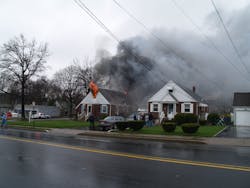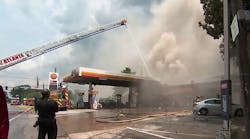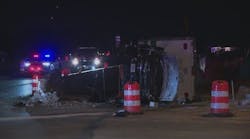If you are like most firefighters, you often look at a photo or video of fireground operations and critique the actions of others, and maybe you even say, “I would have done it differently.” Sometimes these observations are posted on social media, where people pile on in criticism of the actions or possibly to support them. In many cases, little is gained from these exchanges. Might there be a different approach that would allow us to gain real value from the abundance of photo and video documentation of actual incidents?
Central Whidbey Island, WA, Fire & Rescue (CWIFR) is a small combination fire and rescue service serving a rural area on Whidbey Island in the Puget Sound northwest of Seattle. Our members are committed to excellence, but have few opportunities to gain fireground experience. Developing sound thought processes and decision-making skills require deliberate practice. With this in mind, I turn to the concept of “First-Due Questions,” which offers a platform for multiple repetitions of size-up and initial fireground decision-making using photos or video. Let’s first consider where the idea originated and why it can offer so many benefits for firefighters.
The starting point
I have often used photos or video clips when coaching firefighters preparing for the promotional process and new company officers honing their skill in size-up, strategies and tactics, fireground decision-making, and communications. Use of photos aids in developing synthetic experience in the absence of actual fireground operations. CWIFR members know that when they see me approach them in the kitchen, day room or office with an iPhone or iPad, there’s a good chance I’m about to share a photo or video as an opportunity for learning. This form of learning is quick and informal, so I was looking to take it to the next level.
I also felt like we needed to address the challenge of helping firefighters and company officers develop their writing skills. Contrived technical writing assignments are always painful, so I wondered if there was a way to offer writing practice where the feedback would be more welcomed. The answer: Get firefighters to write about the actions they would take at a fire incident.
The intersection of the need for training in initial fireground decision-making and the need to improve the technical writing skills necessary for completing incident reports and other staff work resulted in a tremendous opportunity. What’s more is that the use of written responses to tactical questions provides benefits far beyond the tactical decision-making and improved writing. Richard Menary explains that, “Writing transforms our cognitive abilities.” Specifically, writing can be analyzed, transformed and examined critically with an eye toward improvement. Making our thoughts visible through writing provides a practical method to improve practical actions in completing tasks, such as transmitting a size-up report or developing an initial incident action plan (IAP).
The concept
Each “First-Due Question” presents an incident set in our community (even though the supporting photos or video are of incidents occurring elsewhere). The scenario is set in an actual location where similar buildings are located in order to provide context for response route and water supply operations.
Participants are presented with incident information that would be provided when companies are paged and that would be accessible on the computer aided dispatch (CAD) system. They are then provided with a series of questions that require a written response.
Additional information is interspersed with the questions, but participants are asked not to work ahead and to answer the questions with only the information that has been provided prior to the question they are working on.
When the participant reaches the section where they are deemed “on arrival,” they are provided with photos (or video screenshots) and video (if available) of incident conditions. Additional questions follow, requiring the participants to write their size-up report and answer additional questions related to task and tactical orders provided to their crew and later-arriving companies.
The last few questions ask the participants to explain the Building, Smoke, Air Track, Heat, and Flame (B-SAHF) observed, the stages of fire development, and burning regime (fuel or ventilation limited) and how these observations and conclusions informed their decision-making.
Rationale
After completing one of the first First-Due Questions, one of our lieutenants said that he would much rather answer the questions orally sitting around the kitchen table or in the classroom. I felt his pain but explained that writing is thinking and provides opportunities that you don’t have in other types of practice. Consider arrival reports. Developing proficiency even with a standardized system can be challenging. Arrival reports can often be incomplete or worse—overly long and wordy.
The concept that writing is thinking and that you have the ability to review and revise before declaring the work finished is central to the value of the First-Due Questions concept from the technical perspective, as this provides an opportunity for revision that does not exist during actual incident operations. In addition, it helps develop the habits of review and revision that are critical to technical report writing and other staff work.
The questions
First-Due Questions use a fairly standard set of questions that may be revised slightly based on the circumstances presented by the scenario.
Question 1: What communication will you have with your crew while responding to this incident and what assignments will you make (if any) prior to arrival?
As you approach the incident, you can see smoke in the distance, and you hear Engine 51 responding with three and Engine 54 responding with one crew member. The first two photos illustrate conditions as you approach and arrive at the incident. Note: While the street layout and neighborhood shown in the photos is quite different, keep in mind that we have placed this incident at 1995 Madrona Way.
Question 2: What is your size-up report to ICOM (write it exactly as you would transmit the report)?
Question 3: What orders (if any) would you give the members of your crew before exiting the cab?
Question 4: What action would you take at this point?
On your arrival, the front doors (interior and storm door) are open. During your 360-degree reconnaissance, you look in the front door (Side Alpha) and observe that there is no appreciable smoke on Floor 1 and that there is a stairwell a short distance inside the doorway. Flames are down to floor level on the second floor and you feel a strong in draft of air at the doorway.
Continuing your 360-degree reconnaissance, you observe the following conditions from the Bravo/Charlie Corner.
You observe a door leading from Floor 2 to the deck on Side Charlie with a large volume of flame exiting from this opening. Conditions on Side Charlie Floor 1 and Side Delta are unremarkable with a small amount of light smoke and a door on Side Delta at the Delta/Alpha Corner.
Question 5: What update report would you transmit after completing your 360-degree reconnaissance?
Question 6: What orders would you give your crew upon completing the 360-degree reconnaissance and transmitting an update report? State your assumptions regarding the effectiveness of your initial actions and what would come next for your crew.
Question 7: What assignment would you give Engine 51?
After completing the action-based questions (what would you say, what would you do), the participants are tasked with thinking and writing about what led them to take the actions that they described. This is similar to a Tactical Decision Game (Schmitt, 1994) in that action is taken before discussion.
Question 8: Go back to the photos and video and identify what B-SAHF indicators informed your decisions. Identify the stage(s) of fire development, the burning regime (fuel or ventilation controlled) and describe the fire conditions that you anticipated inside the building (Floors 1 and 2). In addition, explain what lead you to these conclusions.
Question 9: How did incident conditions, observations and your conclusions based on this information influence your choice of strategies and tactics?
A tool in the toolbox
Written First-Due Questions are not the sole answer to developing competence in strategic and tactical decision-making, but they do serve as an excellent tool in pursuit of this goal if integrated with Tactical Decision Games, computer-based simulations as well as analysis and discussion of actual incident responses.
References
Schmitt, J. (1994). Mastering tactics: A Tactical decision games workbook. Quantico, Virginia: Marine Corps Association.
Menary, R. (2007). Writing as thinking. Language Sciences (29), 621-632. Retrieved May 5, 2015 from http://www.academia.edu/178422/Writing_as_Thinking






